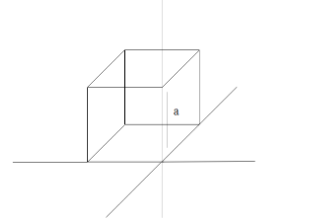
The moment of inertia of a cube of mass m and side (a) about one of its edges is equal to:
A. $\dfrac{2}{3}m{a^2}$
B. $\dfrac{4}{3}m{a^2}$
C. $3m{a^2}$
D. $\dfrac{8}{3}m{a^2}$
Answer
568.8k+ views
Hint: The perpendicular axis theorem is defined as that moment of inertia of a planar lamina about an axis perpendicular to the lamina which is equal to the sum of the moment inertia of the Lamina about the two axes at the right angle to each other in its own plane of intersection to each other.
Complete answer:

According to perpendicular axis:
$I = {I_C} + m{(\dfrac{a}{{\sqrt 2 }})^2}$
$ \Rightarrow (\dfrac{{m{a^2}}}{{12}} - \dfrac{{m{a^2}}}{{12}}) + \dfrac{{m{a^2}}}{2} = \dfrac{2}{3}m{a^2}$
$I = \dfrac{2}{3}m{a^2}$
The term moment of inertia is also known as mass moment of inertia. It is defined as the ratio of net angular momentum of a system to its angular velocity around the principal axis. Moment of inertia plays a very important role in physics which means that in physics problems that involve the mass in rotation motion and that are calculated by angular momentum.
So, the correct answer is “Option A”.
Additional Information:
THERE ARE THREE TYPES OF INERTIA:
a. INERTIA OF REST
b. INERTIA OF MOTION
C.INERTIA OF DIRECTION
If the moment of inertia is increased there will be a slowing down process of speed of rotation. We can also say that the moment of inertia of the body is directly proportional to the mass and it increases as the mass moves further from the axis of rotation.
Note:
Don’t get confused in saying that the moment of inertia and the inertia is the same in nature in physics. No it is not inertia means just the state of the body either it is in motion or rest whereas the moment of inertia is the measurement of resistances of the object against the rotation.
Complete answer:

According to perpendicular axis:
$I = {I_C} + m{(\dfrac{a}{{\sqrt 2 }})^2}$
$ \Rightarrow (\dfrac{{m{a^2}}}{{12}} - \dfrac{{m{a^2}}}{{12}}) + \dfrac{{m{a^2}}}{2} = \dfrac{2}{3}m{a^2}$
$I = \dfrac{2}{3}m{a^2}$
The term moment of inertia is also known as mass moment of inertia. It is defined as the ratio of net angular momentum of a system to its angular velocity around the principal axis. Moment of inertia plays a very important role in physics which means that in physics problems that involve the mass in rotation motion and that are calculated by angular momentum.
So, the correct answer is “Option A”.
Additional Information:
THERE ARE THREE TYPES OF INERTIA:
a. INERTIA OF REST
b. INERTIA OF MOTION
C.INERTIA OF DIRECTION
If the moment of inertia is increased there will be a slowing down process of speed of rotation. We can also say that the moment of inertia of the body is directly proportional to the mass and it increases as the mass moves further from the axis of rotation.
Note:
Don’t get confused in saying that the moment of inertia and the inertia is the same in nature in physics. No it is not inertia means just the state of the body either it is in motion or rest whereas the moment of inertia is the measurement of resistances of the object against the rotation.
Recently Updated Pages
Why are manures considered better than fertilizers class 11 biology CBSE

Find the coordinates of the midpoint of the line segment class 11 maths CBSE

Distinguish between static friction limiting friction class 11 physics CBSE

The Chairman of the constituent Assembly was A Jawaharlal class 11 social science CBSE

The first National Commission on Labour NCL submitted class 11 social science CBSE

Number of all subshell of n + l 7 is A 4 B 5 C 6 D class 11 chemistry CBSE

Trending doubts
What is meant by exothermic and endothermic reactions class 11 chemistry CBSE

10 examples of friction in our daily life

One Metric ton is equal to kg A 10000 B 1000 C 100 class 11 physics CBSE

1 Quintal is equal to a 110 kg b 10 kg c 100kg d 1000 class 11 physics CBSE

Difference Between Prokaryotic Cells and Eukaryotic Cells

What are Quantum numbers Explain the quantum number class 11 chemistry CBSE




